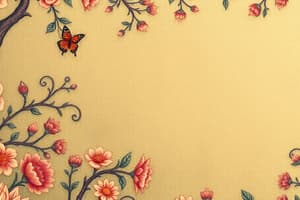Podcast
Questions and Answers
What is the purpose of grouping statements into a function?
What is the purpose of grouping statements into a function?
- To ensure the program does not use more memory than necessary
- To allow the program to run faster by reducing execution time
- To create multiple versions of the same program
- To simplify program management and eliminate code repetition (correct)
What does a function declaration provide to the compiler?
What does a function declaration provide to the compiler?
- The function's memory usage and global variables
- The function's execution time estimates
- The function's name, return type, and parameter types (correct)
- The function body and the return type
What is the role of parameters in a function?
What is the role of parameters in a function?
- To serve as placeholders for the values passed during function invocation (correct)
- To increase the execution speed of the function
- To define the return type of the function
- To store the history of function calls in memory
Which of the following is a characteristic of a 'void' return type in a function?
Which of the following is a characteristic of a 'void' return type in a function?
What does the term 'function signature' refer to?
What does the term 'function signature' refer to?
In the structure of a C++ function, what does the 'function body' contain?
In the structure of a C++ function, what does the 'function body' contain?
Why is it beneficial to use functions in larger programs?
Why is it beneficial to use functions in larger programs?
What information is NOT required in a function declaration?
What information is NOT required in a function declaration?
Flashcards
What is a function?
What is a function?
A group of statements that perform a specific task. It allows you to organize code into reusable blocks, making programs more manageable and readable.
What is a function declaration?
What is a function declaration?
A function declaration tells the compiler about the function's name, return type (the type of value it returns), and parameters (input values it accepts).
What is a function definition?
What is a function definition?
A function definition defines the actual code that the function will execute. It includes the function body where the statements for the task are written.
How do you use a function?
How do you use a function?
Signup and view all the flashcards
What is a function's return type?
What is a function's return type?
Signup and view all the flashcards
What is a function name?
What is a function name?
Signup and view all the flashcards
What are parameters in a function?
What are parameters in a function?
Signup and view all the flashcards
What is a function body?
What is a function body?
Signup and view all the flashcards
Study Notes
Functions
- A group of statements performing a specific operation is called a function.
- Functions group program statements into units and provide names (function names).
- Functions can be invoked anywhere in the program.
- Statements used repeatedly in a program are good candidates for functions.
- Function code is stored in one location in memory.
- Complex programs are divided into functions, simplifying management.
Types of Functions
- Function Declaration: Provides the compiler with information about a function's name, return type, and parameters.
- Function Calling: Invokes the function (executes the function's code).
- Function Definition: Contains the actual code that performs the function's task.
Function Structure
- Name: Unique identifier for the function.
- Parameters: Input values for the function (optional).
- Return Type: Data type of the value returned by the function (optional).
- Function Body: Statements that define the function's task.
Return Type
- Functions can return values.
- The return type specifies the data type of the returned value.
- The keyword
voidindicates no returned value.
Parameters
- Parameters act as placeholders for input values.
- The parameter list defines the type, order, and number of parameters.
- Parameters are optional; functions can have no parameters.
- Actual input values (arguments) are provided when the function is called.
Passing Constants to Functions
- Constants (e.g., integers, characters, floating-point numbers) are passed directly as arguments to functions.
- Example:
line('*');
Function Overloading
- Multiple functions with the same name but different parameters can exist in the same program.
- The compiler distinguishes between these functions based on the number and types of parameters.
Default Arguments in a Function
- A default argument is assigned in a function declaration if a value isn't provided during function calling.
- The compiler substitutes the default value if the user doesn't provide an argument in the function call.
Static Variables
- Static variables are declared using the
statickeyword. - The memory for static variables is allocated once at the beginning of the program's execution.
- Static variables retain their values between function calls.
Passing by Reference
- Pass by reference means that a function receives the memory address (reference) of the variable rather than a copy of its value.
- Changes to a variable inside the function are reflected (updated) in the original variable outside the function, improving efficiency.
Address-of Operator (&)
- The
&operator returns the memory address of a variable. - Addresses are used by pointers, which provide a way to access variable locations in memory (indirectly).
Studying That Suits You
Use AI to generate personalized quizzes and flashcards to suit your learning preferences.




